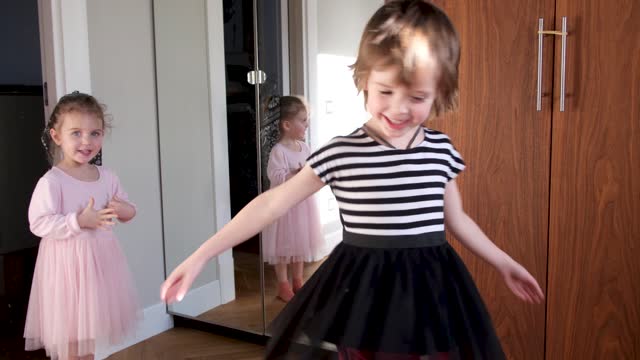Teenagers are known for their rebellious streaks and desire to express themselves in unique ways. For some, this may mean experimenting with fashion and clothing choices that do not conform to traditional gender norms.
As a parent, it can be a challenging and confusing experience to see your teenage son express a preference for wearing dresses. While this may go against societal expectations, it is important to understand and support your child’s gender expression.
Understanding Gender Expression Gender expression refers to the way in which individuals present themselves to the world through their appearance, behavior, and mannerisms. It is a complex and multifaceted aspect of identity that is heavily influenced by cultural and societal norms.
While gender expression is often closely tied to gender identity, it is important to recognize that they are not the same thing. Gender identity refers to an individual’s internal sense of self as male, female, or a gender that is not traditionally recognized.
It is important to support your child’s gender expression, regardless of their gender identity.
Key Takeaways
- Gender expression is the way in which individuals present themselves to the world through their appearance, behavior, and mannerisms.
- Supporting your child’s gender expression is important, regardless of their gender identity.
- Parents can promote autonomy and individuality by encouraging their child’s unique expression of gender.
Understanding Gender Expression

Gender expression is a way in which an individual presents their gender identity to others. It includes the way they dress, act, and behave.
While society often associates certain clothing styles and behaviors with specific genders, it is important to remember that gender expression is a personal choice and can vary from person to person.
For some individuals, their gender expression may not align with traditional gender norms. For example, a teenage boy may enjoy wearing dresses and other traditionally feminine clothing items.
This does not necessarily mean that he identifies as a girl or wants to transition to a different gender. It simply means that he is expressing himself in a way that feels authentic to him.
It is important to support individuals who express their gender in non-traditional ways. This includes using the correct pronouns and respecting their chosen name. It is also important to challenge gender norms and stereotypes that may limit an individual’s ability to express themselves freely.
Parents and caregivers can play a crucial role in supporting their children’s gender expression. By creating a safe and accepting environment, they can help their child feel comfortable expressing themselves in the way that feels right to them.
This can include purchasing clothing items that align with their child’s gender expression and advocating for their child’s rights in school and other settings.
Overall, understanding gender expression is an important step in creating a more inclusive and accepting society. By embracing diversity and challenging traditional gender norms, we can create a world where everyone feels free to express themselves authentically.
The Psychology Behind Dress Preferences
Dress preferences are a personal choice, and there are various factors that can contribute to them. In the case of teenage boys who like to wear dresses, it is essential to understand the psychology behind their dress preferences.
Comfortable Clothing
One of the primary reasons why individuals choose to wear dresses is because they find them comfortable. Dresses provide more freedom of movement and allow for better airflow, which can be particularly appealing during warmer months.
Additionally, dresses can be made from soft, lightweight materials that feel good against the skin.
Expression of Identity
For some individuals, wearing dresses is a way to express their identity and individuality. Clothing can be a powerful tool for self-expression, and dresses can be a way to showcase one’s personality and style.
In the case of teenage boys, wearing dresses may be a way to push back against gender norms and expectations.
Confidence Boost
Wearing a dress can also be a confidence boost for some individuals. The act of wearing something that is traditionally associated with the opposite gender can be empowering and can help individuals feel more confident and self-assured.
This can be particularly important for teenagers who are still figuring out who they are and where they fit in.
Discomfort with Traditional Clothing
Finally, some individuals may simply feel uncomfortable in traditional clothing, such as pants or shorts. For various reasons, these individuals may find that dresses are a better fit for them, both physically and emotionally.
It is important to respect and support these preferences, as everyone deserves to feel comfortable and confident in their own skin.
In conclusion, there are various reasons why teenage boys may choose to wear dresses. Whether it is for comfort, self-expression, confidence, or discomfort with traditional clothing, it is important to understand and respect their choices.
By doing so, we can create a more inclusive and accepting society for all individuals.
Impact on Family Dynamics

When a teenage son likes to wear dresses, it can have a significant impact on family dynamics. Parents may struggle to understand and accept their child’s choices, and siblings may feel confused or embarrassed by their brother’s behavior.
In some cases, moms may be more accepting of their son’s desire to wear dresses, while fathers may struggle with the idea. This can lead to tension and conflict within the family, as each parent tries to navigate their own feelings and opinions on the matter.
Support and love are essential for families in this situation. It is important for parents to show their son that they accept and love him, regardless of his clothing choices. This can help to build trust and strengthen the family bond.
Siblings may also need support and guidance in understanding their brother’s behavior. Parents can help by explaining that everyone is different and has their own unique interests and preferences.
Overall, it is important for families to communicate openly and honestly about their feelings and concerns. With patience and understanding, families can work together to create a supportive and loving environment for their teenage son who likes to wear dresses.
Social Implications and Peer Interactions
When a teenage boy likes to wear dresses, it can have significant social implications and affect peer interactions. While some kids may be accepting and supportive, others may be judgmental or make fun of him.
It is typical for teenagers to want to fit in and be accepted by their peers, and wearing dresses may make him feel like an outsider. He may worry about being judged or ridiculed by the crowd, which can lead to anxiety and low self-esteem.
However, it is essential to remember that every person is unique, and it is okay to express oneself in different ways. Encouraging him to be true to himself and express his individuality can help boost his confidence and self-esteem.
Parents can also help by talking to him about how to handle negative comments or reactions from others. They can teach him coping mechanisms, such as ignoring the comments or walking away from the situation.
Overall, while it may be challenging for a teenage boy who likes to wear dresses to navigate social situations, with support and encouragement from parents and friends, he can learn to embrace his individuality and be confident in who he is.
Addressing Common Misconceptions

When a teenage boy expresses a desire to wear dresses, it can be difficult for parents and others to understand. This often leads to misconceptions about the reasons behind the behavior.
Here are some common misconceptions and the truth behind them:
Misconception: He must be gay
Wearing dresses does not necessarily indicate sexual orientation. Sexual orientation and gender identity are separate aspects of a person’s identity. It is possible for a boy to be attracted to girls and still want to wear dresses.
Misconception: He must be transgender
While some boys who want to wear dresses may be transgender, this is not always the case. Gender identity is a complex and personal experience, and it is not always tied to clothing choices.
It is important to listen to the individual and respect their identity, regardless of whether they identify as transgender or not.
Misconception: He is just seeking attention
It is important to recognize that wearing dresses can be a genuine expression of an individual’s identity, and not simply a cry for attention. It is important to provide a supportive and accepting environment for the individual, rather than dismissing their feelings as attention-seeking behavior.
Misconception: It’s just a phase
While it is possible that a boy’s desire to wear dresses may be a phase, it is important to take their feelings seriously in the present moment.
Dismissing their feelings as a phase can be hurtful and invalidating. It is important to provide support and understanding, regardless of whether or not the behavior persists.
In conclusion, it is important to approach a teenage boy’s desire to wear dresses with an open mind and a willingness to listen. By avoiding common misconceptions and providing a supportive environment, parents and others can help the individual feel validated and accepted.
Coping Mechanisms and Strategies for Parents
Parents of teenagers who like to wear dresses may find themselves struggling to cope with the situation. However, there are several coping mechanisms and strategies that can help parents navigate this challenging time.
Firstly, it is important for parents to support their child and understand that their clothing choices do not define their gender identity.
Parents can show their support by listening to their child and allowing them to express themselves freely. They can also defend their child against any negative comments or discrimination from others.
Parents can also seek support from other parents who are going through similar situations. This can be done through online forums, support groups, or even reaching out to friends and family who may have gone through similar experiences.
In addition, parents can seek professional help from therapists or counselors who specialize in gender identity issues.
These professionals can provide parents with valuable information and resources to help them better understand their child’s situation and provide them with the tools they need to support their child.
Overall, coping with a teenager who likes to wear dresses can be challenging, but with the right support and strategies, parents can help their child navigate this difficult time with confidence and knowledge.
Influences from Pop Culture and Media
Pop culture and media have a significant impact on teenagers’ fashion choices, and it is not uncommon for them to emulate their favorite characters or celebrities.
When it comes to boys wearing dresses, pop culture and media have played a significant role in normalizing gender-neutral clothing.
Here are some examples of how pop culture and media have influenced the fashion choices of teenagers:
- Disney Princesses: Disney has been a significant influence on children’s fashion for decades, and their princesses have been a popular choice for costumes and dress-up. With the introduction of characters like Elsa and Anna from Frozen, who wear pants and dresses interchangeably, it has become more acceptable for boys to wear dresses.
- Books: Books can also influence teenagers’ fashion choices. For example, the book “Julian is a Mermaid” by Jessica Love is about a young boy who loves mermaids and wants to dress up like them. The book has become popular among children and has inspired many to embrace gender-neutral clothing.
- Artists: Many artists have also been vocal about their support for gender-neutral clothing and have incorporated it into their work. For example, Harry Styles, a popular singer, has been seen wearing dresses and skirts, which has inspired many teenagers to do the same.
Overall, pop culture and media have played a significant role in normalizing gender-neutral clothing, and it has become more acceptable for boys to wear dresses.
The Role of Clothing and Toys in Gender Expression

Clothing and toys can play a significant role in a person’s gender expression. Children are often introduced to gendered clothing and toys from a young age, and these items can influence their understanding of gender and gender roles.
For a child who likes to wear dresses, clothing can be a way to express their gender identity. Dresses are often seen as a feminine item of clothing, but they can be worn by anyone regardless of their gender. By wearing a dress, a child can express their gender identity and show the world who they are.
Toys can also play a role in a child’s gender expression. Gendered toys, such as dolls and action figures, can reinforce traditional gender roles and stereotypes. However, children should be encouraged to play with toys that interest them, regardless of their gender.
Color can also be a factor in gender expression. Pink is often associated with femininity, while blue is associated with masculinity. However, these associations are not inherent and can vary by culture and time period.
Children should be allowed to wear and enjoy any color they choose, regardless of gender stereotypes.
Nail polish and makeup are also items that can be used to express gender identity. While traditionally seen as feminine, anyone can wear nail polish and makeup if they choose to.
In summary, clothing and toys can play a significant role in a child’s gender expression. Children should be encouraged to express themselves in ways that feel authentic to them, regardless of gender stereotypes.
Personal Stories and Experiences
Parents of boys who like to wear dresses often have a lot of questions and concerns. They may wonder if this is just a phase or if it is a sign of something more significant. Here are a few personal stories and experiences that may help shed some light on the topic.
One parent shared that their teenage son had been wearing dresses and skirts since he was three years old. At first, they thought it was cute and harmless, but as he got older, they began to worry about how others would perceive him.
They tried to discourage him from wearing dresses, but he persisted, and they eventually realized that it was more important to support him than to try to change him.
Another parent shared that their son began wearing dresses after watching a movie with a male character who wore a dress. He was fascinated by the idea and began asking questions about why boys couldn’t wear dresses too.
The parents were initially hesitant, but they eventually decided to let him wear dresses at home and to family events. They were surprised by how positive the reactions were from their family and friends.
A third parent shared that their son began wearing dresses after seeing a female friend wearing one. He was curious and asked his parents if he could try one on.
They were hesitant at first but eventually agreed. They were surprised by how happy and confident he looked in the dress and decided to support him in his choice.
Overall, these stories show that there is no one-size-fits-all answer to the question of why boys like to wear dresses. It is essential to listen to your child, support them, and let them express themselves in the way that feels right to them.
Promoting Autonomy and Individuality
When it comes to raising a child, it’s important to promote their autonomy and individuality. This means allowing them to express themselves in a way that feels true to their heart. For some children, this might mean expressing themselves through fashion.
If your teenage son likes to wear dresses, it’s important to support their decision and encourage them to express themselves in a way that feels authentic to them. This can help them to feel confident and empowered in their own skin.
One way to promote autonomy and individuality is to have open and honest conversations with your child. Ask them how they feel about their fashion choices and what it means to them. Listen to their response without judgment and show them that you support them no matter what.
Another way to promote autonomy is to allow your child to choose their own clothes. Give them the freedom to express themselves through their fashion choices and encourage them to experiment with different styles.
Ultimately, promoting autonomy and individuality is about supporting your child in the way that feels best for them. By doing so, you can help them to develop a strong sense of self and feel confident in expressing themselves in any way they choose.
Frequently Asked Questions
Is it normal for boys to want to wear dresses?
Yes, it is normal for boys to want to wear dresses. Gender expression is a personal choice and should not be limited by societal norms or expectations.
What to do when your son wants to wear dresses?
Listen to your son and support his choices. Encourage him to express himself in a way that feels authentic to him. You can also talk to him about the importance of being respectful towards others who may not understand or accept his choices.
Why does my son like to wear dresses?
There are many reasons why your son may like to wear dresses. It could be a form of self-expression, a way to feel more comfortable in his own skin, or a way to challenge traditional gender roles.
It is important to respect his choices and not make assumptions about why he likes to wear dresses.
What is a boy that dresses like a girl?
A boy that dresses like a girl is simply expressing his gender in a way that feels authentic to him. It is important to use inclusive language and avoid labeling or stigmatizing individuals based on their gender expression.
How can I support my son who likes to wear dresses?
You can support your son by listening to him, respecting his choices, and advocating for his right to express himself in a way that feels authentic to him. You can also help him find gender-neutral clothing options that he feels comfortable in.
What are some gender-neutral clothing options for boys?
There are many gender-neutral clothing options for boys, including t-shirts, jeans, hoodies, and sneakers. You can also look for clothing that is not specifically marketed towards boys or girls, such as plain-colored t-shirts or sweatpants.
Additionally, you can explore gender-neutral clothing brands that specialize in inclusive and diverse clothing options.
See more in a related post: My Daughter Says She Is Pansexual

Iesha is a loving mother of 2 beautiful children. She’s an active parent who enjoys indoor and outdoor adventures with her family. Her mission is to share practical and realistic parenting advice to help the parenting community becoming stronger.
